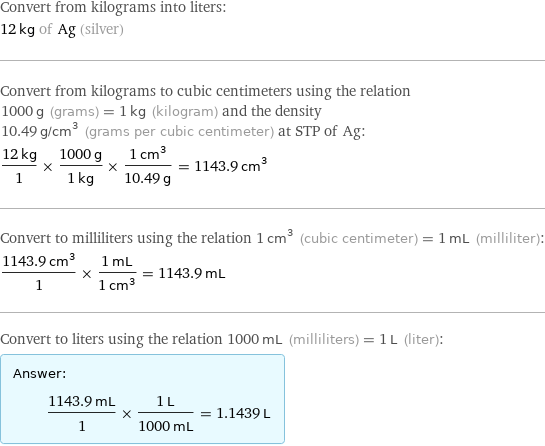Input interpretation

convert 12 kg of silver (chemical element) to volume
Results

1.1439 L (liters)
Possible intermediate steps

Convert from kilograms into liters: 12 kg of Ag (silver) Convert from kilograms to cubic centimeters using the relation 1000 g (grams) = 1 kg (kilogram) and the density 10.49 g/cm^3 (grams per cubic centimeter) at STP of Ag: (12 kg)/1 × (1000 g)/(1 kg) × (1 cm^3)/(10.49 g) = 1143.9 cm^3 Convert to milliliters using the relation 1 cm^3 (cubic centimeter) = 1 mL (milliliter): (1143.9 cm^3)/1 × (1 mL)/(1 cm^3) = 1143.9 mL Convert to liters using the relation 1000 mL (milliliters) = 1 L (liter): Answer: | | (1143.9 mL)/1 × (1 L)/(1000 mL) = 1.1439 L
Unit conversions

0.0011439 m^3 (cubic meters)

1143.9 cm^3 (cubic centimeters)

38.681 fl oz (fluid ounces)

2.4176 pints

1.2088 quarts

0.3022 gallons

0.040398 ft^3 (cubic feet)

69.808 in^3 (cubic inches)
Comparisons as volume

≈ ( 0.051 ≈ 1/20 ) × volume of one mole of ideal gas at 273.15 K and 101.325 kPa ( 0.02241 m^3 )

≈ 2 × volume of a typical human breath ( ≈ 0.5 L )

≈ 18 × volume of an Apple iPhone 4 ( ≈ 6.3×10^-5 m^3 )
Comparisons as volume of food or beverage

≈ 0.69 × volume of a US size 5 can ( 7 cups )

≈ 1.2 × volume of a US size 3 can ( 4 cups )

≈ 1.4 × volume of a US size 2.5 can ( 3.5 cups )
Interpretations

volume

volume of food or beverage

capacity

section modulus
Basic unit dimensions
![[length]^3](../image_source/93643bd22d5543ebc6db210892ddd798.png)
[length]^3
Corresponding quantities

Radius r of a sphere from V = 4πr^3/3: | 65 mm (millimeters) | 0.21 feet | 2.6 inches

Edge length a of a cube from V = a^3: | 10 cm (centimeters) | 0.34 feet | 4.1 inches

Mass m of water from m = ρ_(H_2O)V: | 1.1 kg (kilograms) | 2.5 lb (pounds) | (assuming maximum water density ≈ 1000 kg/m^3)

Molecule number N of water from N = ρ_(H_2O)V/m_(H_2O): | 3.824×10^25 molecules | (assuming maximum water density ≈ 1000 kg/m^3) | (assuming molecular mass of water ≈ 18.02 u)